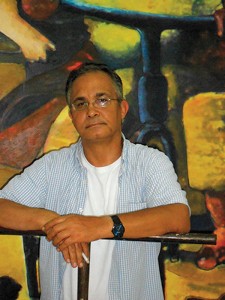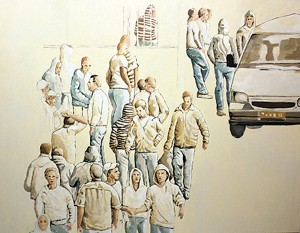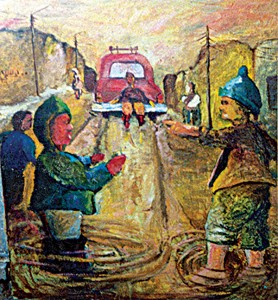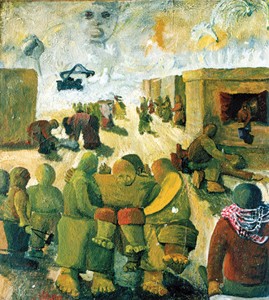 Jawad Al Malhi’s repertoire spans painting, photography, sculpture, video, and site-specific installation. Over the 20 years of his career he has focused on exploring communities – their practices of everyday life and relationship to their environments – often reflecting upon the wider human condition. Al Malhi lives and works in East Jerusalem and was born in Shu’fat Refugee Camp, where he currently lives and has his studio. Established in the 1960s, the camp is only a few kilometers from the Old City of Jerusalem and is home to refugee families like his, who lost their homes in what is now West Jerusalem. The former village of Al Malha is now the site of the Knesset and a shopping mall.
Jawad Al Malhi’s repertoire spans painting, photography, sculpture, video, and site-specific installation. Over the 20 years of his career he has focused on exploring communities – their practices of everyday life and relationship to their environments – often reflecting upon the wider human condition. Al Malhi lives and works in East Jerusalem and was born in Shu’fat Refugee Camp, where he currently lives and has his studio. Established in the 1960s, the camp is only a few kilometers from the Old City of Jerusalem and is home to refugee families like his, who lost their homes in what is now West Jerusalem. The former village of Al Malha is now the site of the Knesset and a shopping mall.
Shu’fat has a major checkpoint terminal and is surrounded by the Separation Wall. Al Malhi initiated The Open Studio in the camp, and over the last 15 years he has undertaken numerous projects that work with children, young people, and teachers, opening up to them new horizons of creativity and self-expression in the city and camp. His studio is regularly open to the local community.

Al Malhi has always been a keen observer of people: “Throughout my work, I see myself in the position of a witness who interprets unrecorded histories of the everyday, through observations that I accumulate over long passages of time of people and their relationship to habitual and public places.” His early monumental oil paintings (1986–1990), such as Day of Peace (1989), Child’s Play (1988), and Winter Rain (1988), depict daily life in the refugee camp during the first Intifada, including community efforts to deal with flooded streets, children’s games, life in the home, and days and nights in the camp. These canvases, with their thick encrusted layers, are inhabited by people who impart a strong sense of community and collectivity, and were created on burlap sacks of sugar and flour distributed to the refugees. “My aim was to record a daily history of the people who engaged in the first Intifada rather than to create stereotypical images of victimized refugees.”

After these monumental paintings his work moved on to study the contradictions and vulnerability of individual subjectivity, which he explored through the abstract representation of human form. His work later moved into photography and video, with a major project House No. 197, which explored the cartography of the camp, although not featured on maps or acknowledged in representations of the holy city. He documented the transformations of this makeshift urban landscape which has been prompted by the necessity to accommodate the growing Palestinian refugee population, over several decades, who live in a perpetual state of waiting. Photographed from the nearby Israeli settlement, the panoramic images reveal the intensely accumulative topographies of the built environment that have become a testimony of dislocation. This project was followed by a body of work that explored the relationship between still and moving image in which he attempted to produce alternative representations of Jerusalem and explored the cacophony of “voiceovers” that are projected onto the city and that probe the representations of the holy city held in fragile tension.
His new body of work sees a return to large-scale painting and sculpture. “Measures of Uncertainty” (2013–2016), which was shown at Al Mamal Art Foundation and most recently with Zawyeh Gallery at Art Dubai (March 16–19, 2016), consists of over 15 large-scale paintings and sculptures that draw inspiration from hours of observing crowds in Palestine and across major cities in the Middle East. He explains that the media image regularly focuses on events and spectacles of the masses, but he is more interested in the details of crowds and how this is reflective of a wider condition.

He comments: “The moment after solidarity dissipates, everything melts into thin air. The moment is filled with uncertainty and trepidation that undulate in the gestures of the disintegrating crowd. Looking onto the scene, people wander in all directions as relations show themselves to be contingent. This is a fleeting moment before the street clears – it is a moment when questions that remain unanswered return.”
Speaking of his new sculptures, he notes, “In my painting series, figures appear as if painted in dust; in my videos, they appear as shadows; in sculpture, they finally take form, however fragile. The sculptures are of everyday people, not monuments to famous individuals, politicians, or war heroes, but to the boys next door whom we see on our streets as active protagonists, observers, and the disengaged, as found in my paintings.”

Apart from many local and international solo exhibitions, Al Malhi has participated in numerous group exhibitions and arts residencies. His works are held in private and public collections in Europe and the Middle East, including the British Museum, the Imperial War Museum, London, UK, and the Barjeel Collection, UAE.

